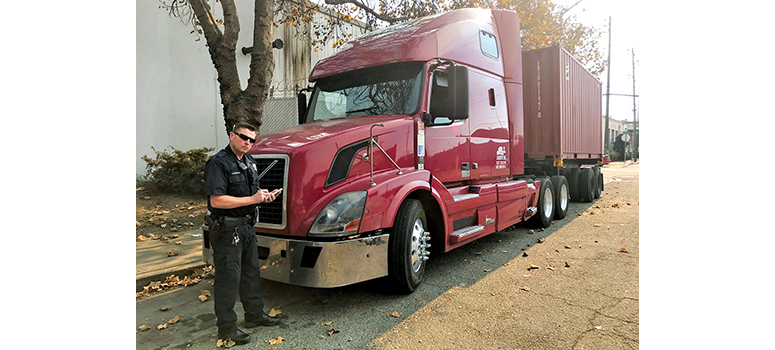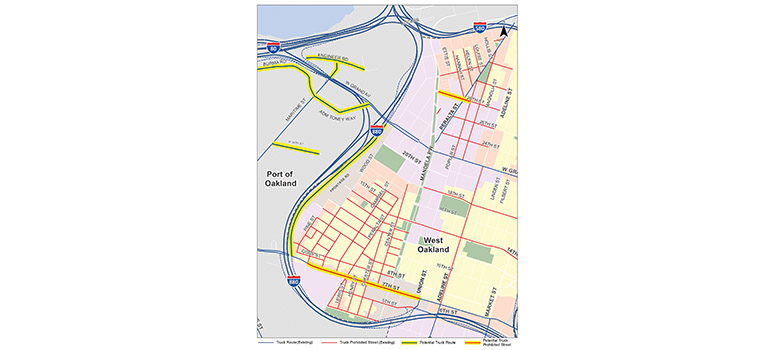At the end of April, the Port of Oakland adopted a strategy for minimizing the impact of port-related truck traffic on the surrounding neighborhood.

Photo courtesy of Port of Oakland
BY BILL PICTURE
Published: June, 2019
At the end of April, the Port of Oakland adopted a strategy for minimizing the impact of port-related truck traffic on the surrounding neighborhood. Port officials are now meeting to flesh out a detailed work plan.
The West Oakland Truck Management Plan tackles everything from keeping truck drivers on prescribed truck routes through the neighborhood, to further restricting truck and trailer parking on residential streets. Its goal, say port reps, is finding a way for truck drivers and West Oaklanders to coexist.
“It’s our responsibility to be a good neighbor in Oakland,” said Port of Oakland Environmental Planner Andrea Gardner in a written statement. Gardner helped develop the plan, which leaves the well-known environmental impact of diesel trucks to the Port’s larger-reaching air quality initiatives and focuses instead on making truck traffic “less annoying” for locals.
“With this plan, we’re keeping our promise to minimize the impact of containerized cargo transportation in Oakland,” Gardner added.
The plan was largely triggered by commercial development at the former Oakland Army Base. Plans for the site, which sits at the base of the eastern span of the Bay Bridge, include, among other things, construction of a new marine terminal and a logistics facility. More truck traffic through West Oakland is expected as a result of this development.
West Oakland is simultaneously experiencing an influx of new residents, drawn to it by new housing developments. So the truck plan, Gardner said, is an attempt to preemptively ease future tensions that might arise between West Oakland residents and the truck drivers who use its streets to get from Point A to Point B.
“There are a lot of changes happening in West Oakland—a lot of development,” Gardner said. “This plan is proactive.”
What’s the problem?
More trucks moving through West Oakland, logically, means an increased potential for accidents. Intersections near freeway onramps and offramps have been identified as likely places for such accidents to occur, so the Port of Oakland is exploring how to ensure these intersections are as safe as possible for everyone—whether they live in the neighborhood or are just passing through it.
“Moving forward we want to make sure plans account for the everchanging mix of users—pedestrians, bicyclists and motorists,” Gardner said.
One way to do that is keeping commercial vehicles on the prescribed trucks routes intended to divert them away from residential streets. Many truck drivers play by the rules and stick to the routes, but some don’t. Some are seeking out fuel or food, while others stray in order to service businesses located off the designated paths.
“I think there’s still a lot of education to be done,” Gardner said. “We have to let them know the routes are there, make them understand why the routes exist, and explain why it’s important that they use them.”
Gardner also believes current signage is inadequate, and that gaps in signage make it easy for drivers to unintentionally stray from truck routes.
But if outreach and better signage don’t work, Gardner has another plan up her sleeve. She said urban design strategies, like roundabouts or bulb-outs, could be employed in residential areas to make it difficult for large trucks to navigate residential streets. A bonus of the backup plan would be the greening opportunity afforded by such strategies, as the design often includes landscaping elements that help beautify an otherwise ordinary four-way stop.
“Outreach to drivers is more economical so we’ll start with that,” she said. “We have to be fiscally responsible. But if we do that and we’re still seeing trucks where they shouldn’t be, then those are the streets we’d target with these strategies.”
Keep it moving
Truck and trailer parking in the neighborhood has for many years been a sore spot for some area residents. Parking restrictions have been imposed as a result, but many streets are still exempt. Gardner hopes to see those loopholes closed before things get out of hand.
“This was a high priority among our stakeholders,” Gardner said.
The West Oakland Truck Management Plan was informed by feedback from a number of sources. A series of community workshops were held where residents, merchants and community groups were invited to chime in and help shape West Oakland’s future. But the port also solicited input from truck drivers, conducting surveys to understand how they operate and what drives the decisions they make.
“They’re the closest to the problems, and the closest to the solutions as well,” Gardner said. “I’d consider one of the highlights of this new plan the way we came to develop it. There was a significant amount of engagement with all stakeholders. Their input drove both the content of the plan and the strategies we identified.”
In general, Gardner said truck drivers really want to do the right thing. “They want to stay in business, and they want to be able to operate in the neighborhood. They want to be good neighbors; and they see helping to support these strategies as a way to do that.”

Truck and trailer parking in West Oakland has been a problem for many years and a sore spot for many area residents. Photo courtesy of Port of Oakland

The Port of Oakland adopted a strategy in April for minimizing the impact of port related truck traffic on the streets of the surrounding neighborhood of West Oakland.

